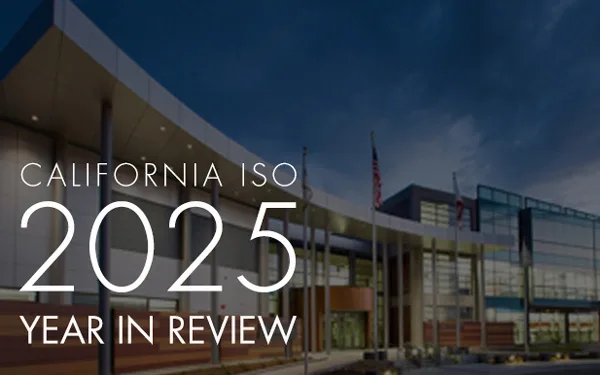G-PST and the value in global efforts supporting low‑emission solutions

Many people know that one of the California Independent System Operator’s primary responsibilities is to help California achieve its clean energy goals. However, fewer people may be aware that the ISO is also engaged in decarbonization efforts globally and it is our belief that success on these two different levels go hand in hand.
With regard to our global efforts, the ISO engages with several international organizations on various educational, knowledge-sharing, and learning initiatives. One specific effort that the ISO works with is the Global Power System Transformation Consortium, or G-PST.
The G-PST is a global consortium focused on support to power system operators with advanced low-emission solutions, including the ISO. This effort was started in 2020 by founding system operators from the United Kingdom, Ireland, Denmark, Australia and the US, such as the California ISO and the Electric Reliability Council of Texas, or ERCOT.
At the ISO, we are on the leading edge of decarbonization efforts, actively integrating one of the largest fleets of inverter based resources like solar and wind power, as well as the largest fleet of energy storage batteries in the world. As such, we have a great deal to learn and also a lot to share from these experiences. The G-PST initiative is an exciting and effective platform that has provided a valuable exchange for the ISO and our global partners who are also seeking to reduce their carbon footprints. The consortium fills a vital need because it exists to drive the development and transfer of the technical and engineering knowledge necessary for power system operators at the speed and scale required to support the global energy transition that is occurring.

G-PST implements activities through five key areas of work: system operator research and peer learning, system operator technical assistance, foundational workforce development, localized technology adoption support, and open data and tools. Each of these areas, or pillars, provides a specific focus and is led by a credible, competent organization including Energy Systems Integration Group (ESIG), National Renewable Energy Laboratory (NREL), Institute of Electrical and Electronics Engineers (IEEE), Imperial College of London and the Technical Research Centre of Finland (VTT). The purpose of each area is outlined below:
System Operator research and peer learning – Performs cutting-edge applied research to create novel system operator solutions, and globally disseminate and infuse new insights through peer learning.
System Operator technical assistance – Provides implementation support to scale established best-practice engineering and operational solutions.
Foundational workforce development – Builds the inclusive and diverse workforce of tomorrow through enhanced university curriculum and technical upskilling for utility and system operator staff.
Localized technology adoption support – Adapts modern power system technologies to individual country contexts through testing program and standards development activities.
Open data and tools – Supports rigorous planning, operational analysis and enhanced real-time system monitoring through open data and tools.
To date, Pillar one (Research and Learning) has produced 15 collaboration pilots on various topics including redefining resource adequacy and grid-forming technologies. Pillar one work has also focused on inverter interoperability and shared Inverter Based Resource (IBR) system test outcomes, as well as developing analysis tools for 100% IBR grids, developing a control room of the future roadmap and an electromagnetic transient (EMT) model standard.
Pillar two has worked supporting Transmission System Operator (TSO) and Distribution System Operator (DSO) entities around the globe through knowledge sharing on critical topics. Work partners from Indonesia, India, South Africa, South America, Mexico and Eastern Europe have benefitted from these discussions, among others. Content discussed has included control room best practices, approaches to System Planning, managing the transition to an IBR-driven grid, support function best practices and reserves policies.
Pillar three has worked with universities and academic leaders to identify industry skill needs and skill gaps and to bridge those gaps through the development of specific curriculum that trains students to operate and plan for the grid of tomorrow. Most of the curriculum modules available to date have been developed by female experts to promote gender diversity in the growing field of power sector transformation.
Pillar four works with grid operators to ensure that standards supporting evolving grids will help maintain reliability as resource mixes change. Standards implementation pilots are ongoing in India and Panama.
Pillar five focuses on developing sharable tools that various grid operators can use, enabling safe and stable system operations under increasingly variable resource mixes. These tools can reduce the transitional costs for the migration to a decarbonized grid. An open-source inertia monitoring toolkit is under development and being deployed in South Africa and Vietnam.
G-PST shares presentations related to the learnings associated with these various work efforts. Those webinars, videos and papers all capture important aspects of the global resource transition including managing an inverter based system, seeing how a 100% renewables based system operates, describing best practices among key reliability topics and exploring new and emerging technologies that are expected to change how grids operate. You can learn more about G-PST and the important work it advances at www.globalpst.org
Meanwhile, here are the G-PST Vision and Mission:
Vision – Dramatically accelerate the transition to low-emission and low-cost, secure, and reliable power systems, contributing to >50% emission reductions over the next 10 years, with $2 billion of government and donor support for technical, market and workforce solutions that unlock $10 trillion+ of private sector investment.
Mission - Our Mission is to bring together key actors to foment a rapid clean energy transition at unprecedented scope and scale by providing coordinated and holistic “end-to-end” support and knowledge infusion to power system operators across the 5 Action Pillars.

As an organization that strives to operate the world’s most reliable, cost-effective and environmentally sustainable power system, sharing what we have learned is part of our culture and value system. We look forward to continuing doing so while also learning from our colleagues around the world through our engagement with the Global Power System Transformation Consortium.


